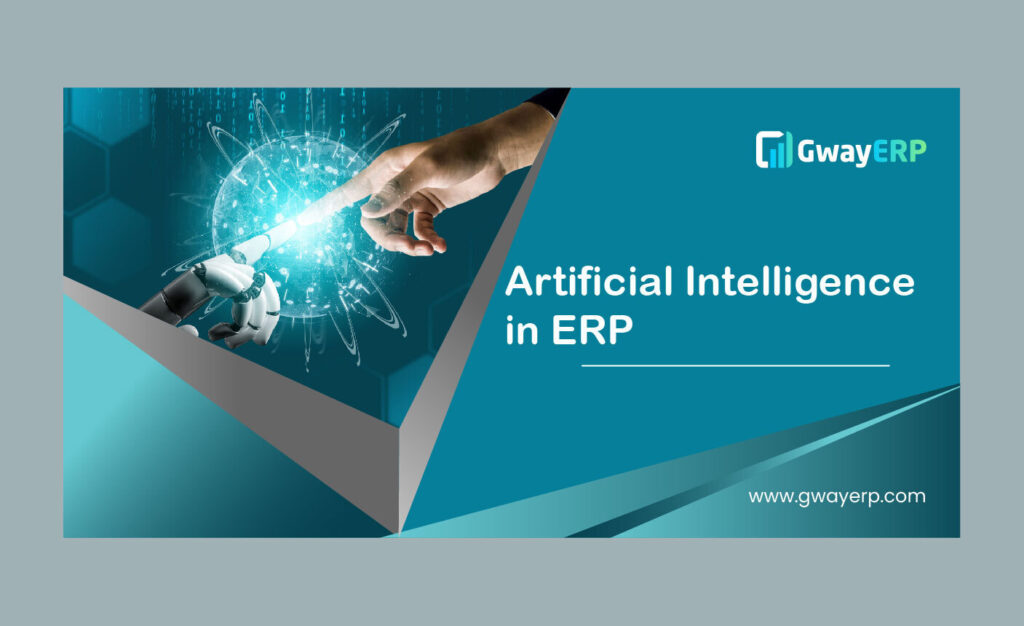
Definition:
A subfield of computer science called AI (Artificial Intellect) tries to build smart computers that are capable of carrying out activities that ordinarily call for human intelligence. Artificial intelligence is utilised for projects like software development, facial identification, expert systems, natural language processing, and picture recognition. AI systems are frequently built to learn and self-improve over time, making them more efficient and accurate. Healthcare, transportation, and manufacturing are just a few of the sectors that AI has the power to transform.
Artificial intelligence in ERP:
AI, or Artificial Intelligence, can be used to improve ERP (enterprise resource planning) solutions in several ways.AI can be used to automate tasks such as financial forecasting, risk management, and inventory optimization. AI can also be used to provide predictive insights into customer behaviour and preferences, allowing companies to make data-driven decisions. Additionally, AI can be used to better analyze large amounts of data, providing businesses with valuable insights and actionable intelligence. Finally, AI can be used to monitor and analyze user behaviour, helping to create personalized experiences and improve customer service.
1. Automated workflow management:
ERP systems employ automated workflow management, a form of automation technology, to automate and simplify company processes and operations. Between many departments, teams, and outside partners, it is utilised to organise and manage the flow of information and tasks. Enhancing organisational effectiveness, cutting expenses, and enhancing customer service are the primary objectives of automated workflow management. Additionally, it may be applied to quicken procedures and improve accuracy. To build and manage intricate approval procedures and tasks, monitor progress and performance, and even provide reports, automated workflow management may be employed. The approval of papers and other crucial procedures may also be managed and automated using it.
2. Predictive analytics:
In ERP systems, predictive analytics may be utilised to improve decision-making, customer service, supply chain visibility, and operational procedures. Utilizing predictive analytics, businesses may predict consumer demands and make better decisions by identifying trends in client usage and purchase behaviours. Additionally, businesses may utilise predictive analytics to forecast client demand, enhance pricing tactics, and enhance inventory management. ERP software may notify management of possible security issues by using predictive analytics to find fraud and other abnormalities in financial transactions.
3. Chatbot integration:
Enterprise resource planning (ERP) system chatbot integration can assist businesses in automating customer support and streamlining operational procedures. Companies may give clients quicker and more precise answers to their inquiries by integrating chatbots with ERP systems, as well as automating procedures like order processing and customer service. Additionally, customer segmentation, marketing initiatives, and other business-related tasks may be automated with chatbots.
4. Real-time insights:
Businesses can enter data into an ERP (enterprise resource planning) system automatically using a method called automated data entry. Numerous software programmes, including optical character recognition (OCR) software, artificial intelligence (AI) algorithms, and robotic process automation (RPA) tools, may be used in this procedure. The time and effort needed to input data into an ERP system may be greatly reduced by using automated data entry, and accuracy can be increased by removing manual mistakes.
5. Automated inventory management:
ERP systems’ automated inventory management is an effective approach to monitoring inventory levels and guaranteeing stock levels are accurate. Inventory management techniques used by ERP systems include barcode scanning, RFID tagging, and automated data collecting. These systems provide for accurate real-time tracking and monitoring of inventory, allowing businesses to act swiftly and intelligently when deciding whether or not to replace their supply. Due to the elimination of human counting and the ability to set the system up to notify users of any inventory discrepancies, automated inventory management also contributes to the reduction of mistakes. Additionally, inventory-level data may be generated by ERP systems, enabling firms to better monitor and anticipate their inventory demands.
6. Automated customer service:
Accounting, inventories, purchasing, sales, human resources, and customer service are just a few of the key business operations that firms use ERP (Enterprise Resource Planning) to handle. ERP can contain capabilities like self-service portals, automated ticketing systems, automated chatbots, and AI-powered virtual agents for automated customer care. By automating repetitive procedures, these solutions can improve customer service operations by allowing customer support representatives to concentrate on more challenging enquiries. By offering faster and more accurate support, automated customer service in ERP may further enhance the customer experience.
7. Automated supply chain management:
ERP systems with automated supply chain management are an effective tool for businesses to improve efficiency and cut expenses. Utilizing software to automate procedures including order processing, inventory management, procurement, and warehouse management. Automation in ERP systems enables businesses to monitor inventory levels, track orders in real-time, and swiftly recognise and respond to changes in demand. This enhances customer service while reducing mistakes and delays in the supply chain. In order to minimise risks and increase revenues, automated supply chain management also provides better visibility and control over the whole supply chain.
ERP (Enterprise Resource Planning) automated procurement and order processing can assist in streamlining and automating the whole procurement and order processing process, from vendor selection through payment. The procurement and order processing process may be made more effective, more affordable, and more accurate thanks to this.
8. Automated procurement and order processing:
ERP may aid in streamlining the process by automating order processing and procurement. Companies may use it to manage their whole ordering and procurement process, find and choose the best providers, and produce purchase orders. It may aid businesses in managing inventories, tracking shipments, and creating invoices.
ERP systems also give businesses the ability to track orders automatically and keep tabs on and evaluate the performance of their vendors. Using this information, businesses may choose vendors and suppliers more effectively.
9. Automated financial forecasting:
Automated financial forecasting is a computer-based method for projecting future financial performance based on historical financial performance data and algorithms. Automated financial forecasting systems build models using previous financial data to predict future financial performance for items like revenue, costs, profits, losses, and cash flows. These models are made to offer decision-makers data-driven insights that can aid in their decision-making with reference to financial planning. Automated financial forecasting systems are frequently used in conjunction with other forecasting methods like budgeting and scenario planning in order to detect prospective risks and opportunities.
10. Automated project management:
The planning, monitoring, and execution of organisational initiatives are all automated through the use of software applications in ERP systems. It facilitates work simplification in project management and boosts the effectiveness of the project team.
The business may use the automated project management system to plan, allocate activities, monitor expenses, detect hazards, and assess and report on project performance. Assigning resources, monitoring the budget and schedule, and keeping track of milestones are all made simpler by automated project management.
Organizations may enhance productivity and accuracy, better control expenses, and produce reports on time with the use of an automated project management system. Additionally, it facilitates improved stakeholder communication and decreases project delays. Organizations may handle projects more effectively and efficiently thanks to automated project management solutions.
11. Voice recognition:
In ERP systems, voice recognition technology may be utilised to automate data entry and improve accuracy. Orders can be easily entered, documentation can be made, and inventory can be tracked. In order to provide safe access to ERP systems, voice recognition may also be utilised for employee authentication. The use of hands-free navigation made possible by this technology enables users to find the information they need with ease and speed.
12. Automated reporting:
The use of automated reporting in ERP software allows for the rapid and effective generation of reports without the need for human creation. Automated reporting may be used to create conventional reports like inventory and financial reports as well as customised reports like customer sales and engineering performance. Drill-down reports and dashboards can also be produced automatically. Reports may be generated using automated reporting in a number of forms, including text, HTML, PDF, and Excel. Using automated reporting, reports may be prepared and emailed to selected people at predetermined periods.
13. Automated scheduling:
ERP (Enterprise Resource Planning) systems’ automated scheduling is one technique to boost productivity and operations. Businesses may organise resources and operations more effectively by employing automated scheduling. This aids in resource optimization and enhances the entire production process. Numerous operations, including arranging manufacturing orders, shipping, and keeping track of equipment use, may be done automatically. By decreasing mistakes and the need for manual intervention, automated scheduling in ERP systems also aids in cost reduction. In order to achieve optimum efficiency, automated scheduling can also assist in ensuring that the appropriate resources are employed at the appropriate moment.
14. Automated invoice processing:
ERP solutions that automate invoice processing are an effective technique to speed up invoice processing. Businesses can rapidly and properly process, track, and manage bills thanks to it. Automated invoice processing may enhance cash flow, decrease manual data input mistakes, and increase accounting process accuracy. Businesses may process invoices reliably and promptly, send reminders for payments, and monitor the status of invoices using an ERP system. As ERP systems may be connected with other software systems to enable direct data transmission, automated invoice processing can also aid in reducing the need for human data entry. As a result, firms may handle their accounts receivable in a more effective way. Automated invoice processing can help companies keep a closer eye on their cash flow and spot inconsistencies.
15. Automated budgeting:
Automated budgeting in ERP systems enables businesses to more correctly and effectively plan, monitor, and evaluate their financial activities. Users that utilise automated budgeting may rapidly produce comprehensive budget reports, make the best choices for resource allocation, and keep an eye on budget performance in real-time. Additionally, it aids businesses in tracking the development of ongoing initiatives and locating prospective cost-saving opportunities. Additionally, automated budgeting may assist to guarantee that every spending is taken into account, lowering the chance of mistakes, and improving insight into the company’s financial situation.
16. Automated document management:
ERP systems’ automated document management is a potent tool for simplifying and enhancing corporate procedures. Organizations may use it to generate, save, manage, and access documents digitally from a single location. It also makes it simpler to obtain papers when needed, eliminating the need for manual document filing and management. The tracking of document versioning and the provision of security controls by automated document management systems can help to guarantee that only authorised people can access critical data. They can also be utilised to streamline departmental document collaboration and automate document approval processes.
17. Automated quality control:
An ERP system’s automated quality control can aid in ensuring that goods and services adhere to predetermined standards and requirements. There are several approaches to applying automated quality control, including the use of automated testing, machine learning, and real-time data analytics.
Before a consumer receives a product or service, possible problems with it can be found using real-time data analytics. Using this information, businesses may see trends in customer complaints, product failures, and other quality-related problems. The production process may then be adjusted using this data to guarantee that quality is maintained. Customer feedback and product performance patterns may be found using machine learning. Businesses may utilise this information to pinpoint areas where their goods need to be improved.
18. Automated marketing campaigns:
ERP systems may be used to send out customised emails or communications to clients or prospects. This contributes to a rise in consumer involvement, client loyalty, and sales. Automated campaigns can be used to provide promotional offers, alerts about fresh goods or services, or future event reminders. Automated campaigns may also be used to segment clients into various customer profiles and target them with pertinent offers and information. Automated campaigns may also be used to monitor consumer involvement and study consumer behaviour.
19. Natural language processing:
ERP systems employ natural language processing (NLP) to comprehend and analyse natural language data from many sources. NLP is used to process unstructured data, including social media postings, consumer reviews, and customer questions. Following an analysis of the data, choices are made about marketing, customer service, and inventory management. Additionally, NLP may be used to automate processes like answering customer enquiries and studying customer feedback to learn more about what products and services to offer.
Conclusion:
AI-driven analytics provide deeper insights into data, enabling more informed decision-making and proactive strategy formulation. This integration also reduces operational costs through optimized resource allocation and improved productivity. Scalability is enhanced as AI algorithms adapt to changing business needs, supporting growth without significant manual intervention.
Furthermore, AI-powered ERP systems enhance customer experiences by personalizing interactions and improving service delivery. They also bolster compliance efforts by monitoring transactions and detecting anomalies, thereby mitigating risks and ensuring regulatory adherence. Overall, AI in ERP automation drives operational excellence, innovation, and competitive advantage in today’s dynamic business landscape.

